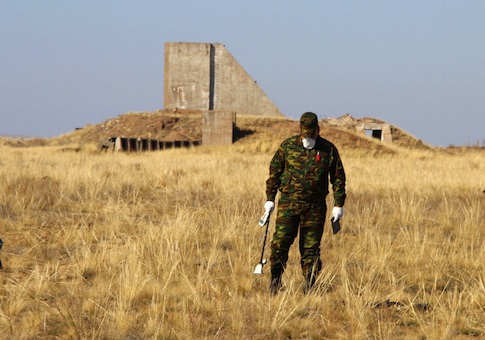A recent report reveals that a former Soviet nuclear test site in Kazakhstan was left unsecured for nearly two decades after the communist union’s collapse and urges the United States and international community to remain vigilant in preventing nuclear materials at similar sites from falling into the hands of terrorists or belligerent states.
The Semipalatinsk test site at Degelen Mountain in northeastern Kazakhstan, near the nation’s Russian border, was secured just last year after a 17-year, $150 million multilateral effort financed entirely by the United States, according to the 40-page report released earlier this month by the Belfer Center for Science and International Affairs’ Project on Managing the Atom.
The Soviets conducted more than 450 nuclear tests at Semipalatinsk—a site almost the size of New Jersey—during the Cold War era, but largely deserted the area after their union’s disintegration in 1991. They left behind enough plutonium residue in abandoned tunnels and bore holes to construct dozens of nuclear bombs.
Despite a $6 million U.S. program that sealed 181 of the tunnels and 13 of the test shafts by 1997, scavengers in search of valuable metals continued to roam the site when Siegfried Hecker—former director of Los Alamos National Laboratory in New Mexico—visited the following year. Some of the scavengers did break into vessels containing the experiments, which also lay outside the tunnels, but did not appear to remove any plutonium, the report states.
Hecker, now a senior fellow at Stanford University’s Center for International Security and Cooperation (CISAC), recounted the threat that terrorists or other malevolent actors could seize the materials in a CISAC Q&A titled, "One of the greatest nuclear nonproliferation stories never told."
"I was alarmed to find unmanned guard posts and virtually no security at the site. My Los Alamos colleagues and I became convinced that Semipalatinsk was not only a serious proliferation problem, but also an urgent one," Hecker said.
"The copper cable thieves were not nomads on camelback, but instead they employed industrial excavation machinery and left kilometers of deep trenches digging out everything they could sell. We were concerned that some of that copper cabling could lead to plutonium residues."
Hecker eventually convinced scientists from financially strapped Russia and Kazakhstan to join the United States and take action. The three nations, backed by the U.S. Cooperative Threat Reduction Program (CTR), developed methods to conceal the fissile materials, such as filling the tunnels with a special type of cement that chemically bonded with the materials and rendered them unusable for weapons purposes. The site was also equipped with cameras, sensors, and drones for surveillance.
Officials toasted to the conclusion of the three nations’ work in October 2012 and erected a stone monument etched with the phrase, "The world has become safer."
However, the report cautioned that loose plutonium "remains a concern at Semipalatinsk" as negotiations continue to remove soil with residues at the site and store it in the mountain.
"Even for the cemented plutonium, a state-backed enterprise might have the means to remove the plutonium, reprocess it, and reassemble it into a weapon. Indeed, this undertaking would likely be no more expensive or difficult than the conventional means of plutonium production, which requires the construction of a nuclear reactor and the reprocessing of spent fuel from the reactor," the report states.
"And even substantial non-state enterprises—like the major scavenging operations that were underway before—might someday be able to reach the plutonium, if monitoring of the site ceases."
The report recommends that the three nations "make it a top priority" to secure the remaining plutonium at Semipalatinsk and also raises concerns about the Novaya Zemlya site in Russia’s Arctic north, the other former Soviet test ground that remains active but has garnered less attention.
Additionally, test sites like the French one in the Algerian Sahara, and more primitive ones in Pakistan, India, and North Korea, also pose a threat.
"Ultimately no substantial amount of recoverable plutonium should be left unsecured anywhere in the world," the report says.
Professor William Martel of Tufts University’s Fletcher School of International Affairs said in an interview that the "loose nukes problem" was again spotlighted after the Sept. 11 terrorist attacks and reports that al Qaeda was willing to offer $100 million to obtain a nuclear weapon.
Those reports lent credence to the theory of convergence, posited by experts such as former supreme NATO commander and Fletcher School dean Adm. James Stavridis. Convergence refers to the threat that globalization and the information revolution could lead previously unrelated adversaries to collude and share resources, technology, and weapons.
Rather than focusing on the convergence threat in former Soviet countries, Iran, North Korea, and Syria, U.S. national security officials have become sidetracked by disputes with Russia, Martel told the Washington Free Beacon. U.S. relations with Russia have deteriorated in recent months over disagreements about human rights, missile defense, Russian support of President Bashar al-Assad’s regime in civil war-torn Syria, and the granting of asylum to NSA leaker Edward Snowden.
"The relations between Moscow and Washington are so strained right now. We don’t want to see these crucial national security programs sacrificed to the war of rhetoric between Moscow and the White House," Martel said.
"We really have to keep our eye on the ball with respect to WMDs."
The prospect that jihadists fighting Assad in Syria could raid his chemical weapons stockpile is just the latest example of the persistent WMD threat, Martel added.
"It remains the great threat to the U.S., and it shows no signs of dissipating," he said.
